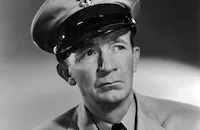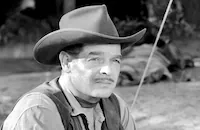Come and Get It

Brief Synopsis
Cast & Crew
Howard Hawks
Edward Arnold
Joel Mccrea
Frances Farmer
Walter Brennan
Andrea Leeds
Film Details
Technical Specs

Synopsis
Barney Glasgow, the affable manager of a logging camp, is overjoyed that his men have done a good job this year. His commission means that he can go home and marry Emma Louise, his boss's daughter, and make a success of himself. Celebrating after the season, he and his friend Swan Bostrom go to a saloon where they are impressed by the singing and demeanor of Lotta Morgan. Lotta and Barney fall in love, but Barney cannot bring himself to give up his goal of wealth for love, and he leaves her. She then marries Swan, whom she regards as the kindest man in the world. Many years later, Barney has married Emma and has two grown children, Evvie and Richard. His only happiness comes from the feisty Evvie, who convinces him to visit Swan, whom he has not seen for several years. When Barney arrives at Swan's home, Lotta has been dead for some time, but her daughter, also named Lotta, is as beautiful as she. Barney becomes infatuated with the girl, who innocently thinks that Barney regards her as a daughter. He showers her and her cousin Karie with gifts, then brings them and Swan back to his home town, where he offers Swan a meaningless job. Because the town begins to gossip about Barney and Lotta, Richard goes to her home to confront her. They argue, but when she realizes that Barney's affection for her is not paternal, she and Richard become friends and soon fall in love. Meanwhile, Barney is upset to learn that Evvie plans to marry Tony Schwerke, a "beau hunk" who is a unionizer at Barney's factory and has invented a new, disposable paper cup with Richard. Barney also quarrels with Richard when he discovers that he and Lotta have been seeing each other, and arranges to have him sent to the family's New York factory. At a company party at Barney's house, Richard and his father again quarrel over Lotta and almost come to blows when Lotta warns Richard not to hurt Barney because he is an old man. Hurt and ashamed, Barney stands idly by as Richard and Lotta walk out of his life. Now alone, Barney is comforted by Emma, who tells him that she is glad that it is Richard who has gone away because she was worried that it might have been Barney. Barney then rings the dinner chime and calls out "Come and get it," with tears in his eyes.

Cast

Edward Arnold

Joel Mccrea

Frances Farmer

Walter Brennan

Andrea Leeds
Frank Shields

Mady Christians

Mary Nash

Clem Bevans
Edwin Maxwell

Cecil Cunningham
Harry Bradley
Rollo Lloyd

Charles Halton
Phillip Cooper
Al K. Hall
Jack Pennick
Earle Hodgins

Robert Lowery
Fred Toones
Gino Corrado
Doodles Weaver
Crew
Ray Binger
Edward Curtiss
Richard Day
Paul Eagler
Max Factor
W. W. Fosdick
Jules Furthman
Samuel Goldwyn
Julia Heron
Merritt Hulburd
Don Keyes
Omar Kiam
Frank Maher
Rudolph Maté
Walter Mayo
Jane Murfin
Alfred Newman
George R. Poulton
Richard Rosson
Gregg Toland
Western Costume Company
Paul Widlicska
Paul Widlicska

Videos
Movie Clip




Film Details
Technical Specs

Award Wins
Best Supporting Actor
Award Nominations
Best Editing
Articles
Come And Get It - Come and Get It
The story would have been more appealing to Hawks than to Wyler, with its blend of rugged adventure and romance, and Hawks was certainly the first director to sign on. The tale begins in 19th-century Wisconsin, where Bernard "Barney" Glasgow, smoothly played by Edward Arnold, is a lumberman with corporate ambitions that involve marrying the boss's daughter. He falls in love with Lotta (Frances Farmer), a saloon singer with a lovely smile and a throaty voice, but leaves her when his marriage of convenience can't be postponed any longer. Lotta marries his best friend, a boisterous Swede named Swan (Walter Brennan), then dies a quiet off-screen death. Many years later, Barney meets their daughter, also named Lotta (and also played by Farmer), and falls in love all over again. Barney's son (Joel McCrea) also tumbles for Lotta Jr., setting up a struggle with Barney, who's still married to the boss's daughter, not to mention being a little old for this sort of thing.
The credits say Come and Get It is "based upon the famous novel by Edna Ferber," although Hawks claimed it was based on the story of his own grandfather. He may have meant he used his ancestor's experiences when he fleshed out the screenplay by Jane Murfin and Jules Furthman, trying to make the second half more physically exciting and psychologically compelling. Be this as it may, Hawks did a lot of rewriting while producer Samuel Goldwyn was away having abdominal surgery.
Then trouble started, due less to Hawks's tinkering than to uncertainty over what exactly he wanted. His assistant later reported that "strain, indecision, and malevolence" stalked the production as Hawks fretted about the storyline and shot scenes before the actors felt prepared. Then the producer returned home to recuperate. Hawks biographer Todd McCarthy says Hawks was prepared for fireworks when Goldwyn, who idolized important writers, discovered he'd tampered with Ferber's plot. Hawks was right: Goldwyn hit the ceiling, and things got worse when he learned that new material he liked had been penned by Hawks himself. "Writers should write and directors should direct!" the producer allegedly yowled.
Hawks resigned in a huff, if you believe his account, or got fired by Goldwyn, if you believe his account. What's certain is that Hawks left the premises on the 42nd day of production, and that after an eight-day shutdown Goldwyn replaced him with William Wyler, who'd just finished Dodsworth (1936) and was still under contract. Wyler's grumpiness about the job alienated Farmer, who said acting with him was "the nearest thing to slavery," but after 28 more days the picture was finished. It's ironic that Wyler used material written by Hawks for the ending, preferring this to the screenplay's own conclusion.
Hawks told film critic Robin Wood that he shot all but 800 feet, or about ten minutes, of the completed film. McCarthy says Wyler contributed more than this, but less than Goldwyn implied when he told Ferber he "threw away most of what Hawks photographed." For viewers today, the fun begins when we try to determine which scenes came from which director. Wood says the beginning of the movie, with its exciting lumberjack footage, "clearly" has Hawks's touch-but to add one more complication, the credits say these scenes were directed by Richard Rosson, who'd co-directed Scarface (1932) and Today We Live (1933) with Hawks in the early 1930s.
Aside from the logging material, there's no certain way of telling which scenes were directed by whom. Still, it's pretty obvious that some material in the film's first half contains patented Hawks touches-people bonding over cigarettes, finding togetherness in a sing-along, and working at a tough men-only job away from ordinary society. And it's equally obvious that Wyler influenced the off-kilter camera angles and striking use of a stairway setting in the last half hour-perhaps working with cinematographer Gregg Toland, whose deep-focus framings would later be crucial not only in Orson Welles's legendary Citizen Kane (1941) but also in Wyler's masterpieces The Little Foxes (1941) and The Best Years of Our Lives (1946). Wouldn't you know, Toland was only one of the Come and Get It cinematographers; the other was Rudolph Maté, fresh from Dodsworth.
Come and Get It has at least three elements that hold up very well: the rough-and-tumble logging scenes; the complex characterization of Barney, who never becomes a clean-cut hero or a clear-cut villain; and Farmer's fascinating performance as both Lotta characters, who look alike but speak and sing in different tones and registers. Today's viewers will probably have less tolerance for Brennan's stereotyped Scandinavian-so overdone that his character actually writes letters with a Swedish accent!
The picture received strong reviews in 1936, largely because of the lumberjack material, and because critics felt a good balance had been struck by the two directors. (Little did they know how much unhappiness was generated behind the scenes!) Admitting that it wasn't "a thoroughly Ferber work," the New York Times critic called it "genuinely satisfying" and "a vividly toned portrait of a man."
Ferber agreed it wasn't thoroughly Ferber, turning down publicity requests because the movie underplayed the novel's environmental concerns. Yet she praised Goldwyn for "throwing out the finished Hawks picture" and starting again from scratch, which of course he hadn't done. In any case, the box-office returns were underwhelming despite a solid marketing push. Variety blamed Arnold, who didn't have "quite enough on the ball to pull 'em in alone," and the lack of female stars--true enough at the time, although today Come and Get It shines as arguably the finest achievement in Farmer's troubled career.
Producer: Samuel Goldwyn
Directors: Howard Hawks, William Wyler
Screenplay: Jane Murfin, Jules Furthman, based on Edna Ferber's novel
Cinematography: Gregg Toland, Rudolph Mate
Film Editing: Edward Curtiss
Art Direction: Richard Day
Music: Alfred Newman
Cast: Edward Arnold (Bernard "Barney" Glasgow), Joel McCrea (Richard Glasgow), Frances Farmer (Lotta Morgan, Lotta Bostrom), Walter Brennan (Swan Bostrom), Mady Christians (Karie), Mary Nash (Emma Louise Glasgow), Andrea Leeds (Evvie Glasgow), Frank Shields (Tony Schwerke); Edwin Maxwell (Sid LeMaire), Cecil Cunningham (Josie), Charles Halton (Mr. Hewitt).
BW-99m.
by Mikita Brottman and David Sterritt

Come And Get It - Come and Get It
Quotes
Trivia
Director Howard Hawks was replaced by William Wyler after Hawks was rude to producer Samuel Goldwyn.
Notes
A news item in Daily Variety in July 1935 noted that producer Samuel Goldwyn was negotiating with author Edna Ferber for the rights to her novel Come and Get It, but negotiations were temporarily snagged because Ferber refused to sell the story without retaining television rights. The news item also noted: "Though the television around the corner subject has been rife for some time, this is thought to be the first occasion where the inclusion of sight-radio rights have held up the sale of a novel to the screen." Other contemporary news items note that Miriam Hopkins was the first choice to play the lead, followed by Virginia Bruce, whom Goldwyn was attempting to borrow from M-G-M; tennis star Francis X. "Frank" Shields made his acting debut in the picture; portions of the film were shot on location in Northern Idaho; and a logging short was made to accompany the film. According to production charts and news items in Daily Variety and Hollywood Reporter, when shooting began on the picture in late June 1936, Howard Hawks was the sole director. In mid-August 1936, Hawks left the picture over what an Hollywood Reporter news item termed "a story dispute" with Goldwyn. Shooting resumed with a revised script on 19 Aug, under the direction of William Wyler, and continued until late September 1936. According to a Hollywood Reporter news item on September 26, 1936, Goldwyn had determined to give full director credit to Wyler who had shot "half" of the picture, however, the onscreen credits of the released film include director credit for both Wyler and Hawks. Some modern sources have indicated that Wyler worked on the picture for about one week, however, news items and production charts in Hollywood Reporter indicate that Wyler worked on the film for at least four weeks. Modern sources add that Wyler did not want to work on the film but was forced to take on the assignment after being threatened with legal action by Goldwyn; Wyler then attempted to shoot the film as closely as possible to Hawk's original design. Modern sources also note that at one time Spencer Tracy was wanted for the lead and that Edna Ferber was hired as a consultant for the film.
The world premiere of the film was held at the Liberty Theatre in Seattle, where actress Frances Farmer had once worked as an usherette. Farmer made a personal appearance at the premiere. Events surrounding the making of Come and Get It and the Seattle premiere were dramatized in the 1982 biographical film Frances, starring Jessica Lange, and the 1983 television movie Will There Really Be a Morning?, starring Susan Blakely, and based on Farmer's autobiography. Farmer was borrowed from Paramount for Come and Get It, which was her first starring role. She continued to act in films until 1942, when personal problems and confinement in a mental hospital resulted in the end of her career. She made one additional film in the 1950s, Party Crashers (1958), and also appeared on television before her death in 1970. In interviews, director Hawks said that Farmer was the best actress with whom he ever worked, and modern critics have called Come and Get It her best film.
Actor Walter Brennan won the first of his three Academy Awards for Best Supporting Actor for this film. Modern sources include the following additional cast members: Stanley Blystone, Constantine Romanoff, Harry Tenbrook and Max Wagner (Lumberjacks); Lee Shumway (Diner); George Humbert (Headwaiter); Egon Brecher (Schwerke); William Wagner (Wine steward); Bud Jamison (Man in saloon); and Fred Warren (Pianist). Edward Arnold recreated his role for a Lux Radio Theatre broadcast on November 15, 1937.

Miscellaneous Notes
Released in United States Fall October 29, 1936
Released in USA on video.
Released in United States Fall October 29, 1936















